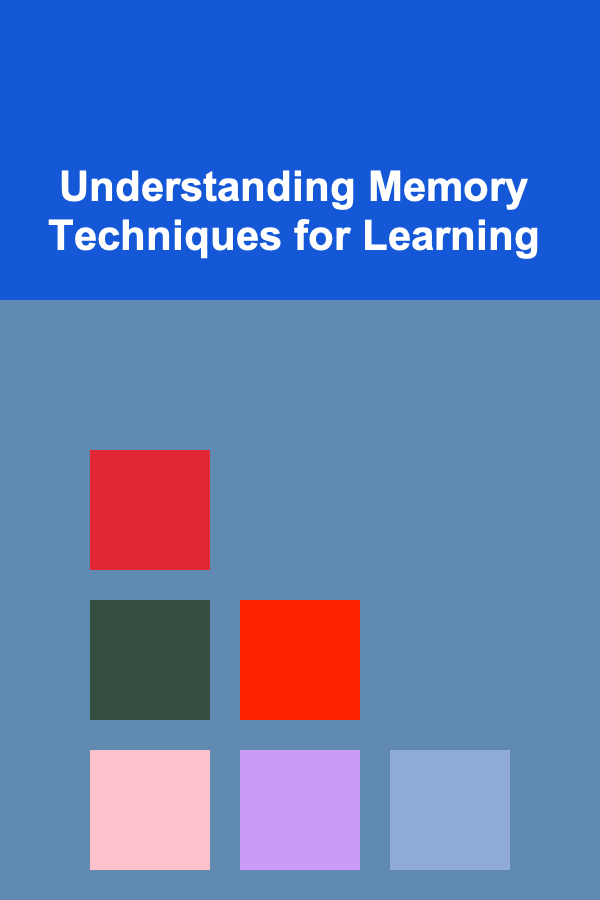
Understanding Memory Techniques for Learning
ebook include PDF & Audio bundle (Micro Guide)
$12.99$5.99
Limited Time Offer! Order within the next:

Memory techniques, often referred to as mnemonics, are strategies used to improve the encoding, storage, and retrieval of information in the human brain. They are not about having a naturally "good" memory, but rather about leveraging the way our brains already work to make information more memorable. This article delves into the core principles behind these techniques, explores a variety of popular methods, examines the scientific underpinnings of their effectiveness, and provides guidance on how to effectively incorporate them into your learning process. We will explore not just what these techniques are, but why they work and how to tailor them to individual learning styles and subject matter.
The Foundation: How Memory Works
Before diving into specific techniques, it's crucial to understand the basics of human memory. The most widely accepted model is the multi-store model, which proposes three distinct memory stores:
- Sensory Memory: A very brief, high-capacity storage system that holds sensory information for a fraction of a second. It acts as a buffer, allowing the brain to select what information to attend to.
- Short-Term Memory (STM) or Working Memory: A limited-capacity storage system that holds information for a short period (seconds to minutes). Working memory is not just about storage; it's also involved in processing and manipulating information. It's like the RAM of your brain.
- Long-Term Memory (LTM): A relatively permanent and limitless storage system. This is where knowledge, experiences, and skills are stored.
The key to effective learning lies in transferring information from short-term to long-term memory. This transfer is not automatic. It requires effortful processing and consolidation. Memory techniques facilitate this process by making information more meaningful and engaging, thus increasing the likelihood of it being encoded and stored effectively in long-term memory.
Key Principles Underlying Memory Techniques
Most memory techniques rely on a few core principles that exploit the natural workings of the brain:
- Association: Linking new information to existing knowledge. Our brains are networks of interconnected concepts. Creating associations between new and familiar ideas makes the new information easier to retrieve.
- Imagination: Creating vivid and unusual mental images. The more bizarre and engaging the image, the more memorable it tends to be. This is because our brains are wired to pay attention to novelty and unexpected events.
- Location: Organizing information spatially. This taps into our inherent spatial memory abilities, which are highly developed due to our evolutionary need to navigate our environment.
- Elaboration: Processing information deeply and meaningfully. This involves asking questions, making connections, and thinking critically about the material. Elaboration strengthens memory traces and makes information more resistant to forgetting.
- Repetition: Revisiting information over time. Spaced repetition, in particular, is highly effective for consolidating memories and transferring them to long-term storage.
- Emotion: Connecting information to emotional responses. Information tied to emotions, whether positive or negative, is generally remembered more vividly.
A Toolkit of Memory Techniques
Numerous memory techniques exist, each leveraging these core principles in different ways. Here are some of the most popular and effective methods:
1. The Method of Loci (Memory Palace)
One of the oldest and most powerful memory techniques, the Method of Loci involves associating items you want to remember with specific locations along a familiar route or within a familiar place, like your house or neighborhood. The "loci" are these locations. To recall the items, you mentally "walk" through your chosen location, retrieving each item as you encounter its associated place. This leverages our strong spatial memory.
How it works:
- Choose a familiar location: This could be your house, your commute to work, or any place you know well. The more detailed and familiar, the better.
- Identify distinct locations: Within your chosen location, identify a series of distinct locations in a logical order. For example, in your house, this could be the front door, the living room, the kitchen, the bedroom, etc.
- Associate each item with a location: Create a vivid and memorable image that connects each item you want to remember with one of the locations. The more bizarre and engaging the image, the better.
- Recall: Mentally walk through your chosen location, visualizing each location in sequence. As you encounter each location, the associated image will trigger the recall of the corresponding item.
Example: Let's say you need to remember a grocery list: milk, eggs, bread, cheese, apples. Using your house as the memory palace:
- Front Door: Imagine a giant carton of milk blocking your front door, so you have to climb over it to get inside.
- Living Room: Picture eggs bouncing around on the sofa, cracking and making a mess.
- Kitchen: See a giant loaf of bread rising so high in your kitchen, it touches the ceiling.
- Bedroom: Imagine a giant cheese wheel sitting on your bed.
- Bathroom: Visualize apples floating in the bathtub.
When you need to remember the grocery list, mentally "walk" through your house, and the vivid images will help you recall the items.
2. Acronyms and Acrostics
Acronyms and acrostics are techniques that use the first letters of a list of items to create a memorable word or phrase. Acronyms use the first letters to form a word (like NASA), while acrostics use the first letters to form a sentence or phrase.
How it works:
- Identify the items to remember: List the items in a specific order if order is important.
- Create an acronym or acrostic: Use the first letter of each item to create a memorable word or phrase. The more creative and unusual the acronym or acrostic, the more likely it is to be remembered.
- Practice: Practice recalling the items using the acronym or acrostic as a prompt.
Example (Acronym): To remember the colors of the rainbow (Red, Orange, Yellow, Green, Blue, Indigo, Violet), you can use the acronym ROY G. BIV.
Example (Acrostic): To remember the order of planets from the sun (Mercury, Venus, Earth, Mars, Jupiter, Saturn, Uranus, Neptune), you can use the acrostic "My Very Educated Mother Just Served Us Noodles."
3. Rhyming
Rhymes are inherently memorable due to their rhythmic structure and auditory appeal. Creating rhymes to associate with information can significantly enhance recall.
How it works:
- Identify the information to remember: Break down the information into key concepts.
- Create a rhyme: Craft a rhyme that links the key concepts in a memorable way. The rhyme should be simple, catchy, and relevant to the information.
- Practice: Repeat the rhyme several times to solidify it in your memory.
Example: To remember the number of days in each month, you can use the rhyme: "30 days hath September, April, June, and November. All the rest have 31, Except February alone, Which has 28 days clear, And 29 in each leap year."
4. Chunking
Chunking involves grouping individual pieces of information into larger, more meaningful units. This reduces the number of items that need to be stored in short-term memory, making it easier to transfer them to long-term memory.
How it works:
- Identify the information to remember: Break down the information into smaller pieces.
- Group the pieces into meaningful chunks: Look for patterns, relationships, or common characteristics that allow you to group the pieces into larger units.
- Memorize the chunks: Focus on memorizing the chunks rather than individual pieces of information.
Example: Instead of trying to remember a phone number as a series of individual digits (e.g., 5551234567), you can chunk it into three groups (e.g., 555-123-4567). This significantly reduces the cognitive load and makes the number easier to remember.
5. Storytelling (Narrative Chaining)
Narrative chaining involves creating a story that links together the items you want to remember. This technique leverages our natural ability to remember narratives and create meaningful connections between disparate pieces of information. The more bizarre and engaging the story, the more memorable it will be.
How it works:
- Identify the items to remember: List the items in a specific order if order is important.
- Create a story: Craft a story that links together the items in a logical and engaging way. The story should be vivid, memorable, and ideally incorporate some element of humor or surprise.
- Visualize the story: Visualize the story in your mind, paying attention to the details and sensory experiences.
- Recall: Retell the story, focusing on the sequence of events and the connections between the items.
Example: Let's say you need to remember to buy milk, eggs, bread, and butter. You could create the following story: "A carton of milk walked into a grocery store and tripped over a giant egg. The egg splattered all over a loaf of bread, making it soggy. A stick of butter, witnessing the chaos, jumped off the shelf and started tap-dancing."
6. Peg System
The peg system involves associating numbers with specific images or words (the "pegs"). You then associate the information you want to remember with these pegs. This provides a structured framework for memorizing ordered lists.
How it works:
- Create a peg list: Memorize a list of number-image associations. A common peg list is the rhyme: "One is a bun, two is a shoe, three is a tree, four is a door, five is a hive, six is sticks, seven is heaven, eight is a gate, nine is a line, ten is a hen."
- Associate each item with a peg: Create a vivid and memorable image that connects each item you want to remember with one of the pegs.
- Recall: To recall the items, go through your peg list and retrieve the associated images.
Example: Let's say you need to remember a list of historical events in order: 1) The French Revolution, 2) The American Civil War, 3) World War II.
- One is a bun (French Revolution): Imagine a giant hamburger bun dressed in a French revolutionary uniform, waving a flag.
- Two is a shoe (American Civil War): Picture a pair of cowboy boots fighting each other, representing the opposing sides of the Civil War.
- Three is a tree (World War II): See a Christmas tree covered in grenades and miniature tanks.
7. Spaced Repetition
Spaced repetition is a learning technique that involves reviewing material at increasing intervals over time. This technique is based on the forgetting curve, which shows that we tend to forget information rapidly after we first learn it. By reviewing the material at increasing intervals, we can combat the forgetting curve and strengthen our memories.
How it works:
- Learn the material: Initially, learn the material as you normally would.
- Review the material: Review the material shortly after learning it (e.g., within a few hours).
- Increase the intervals: Review the material again after a longer interval (e.g., one day, then three days, then one week, then two weeks, then one month, etc.).
- Adjust the intervals: Adjust the intervals based on your recall performance. If you are struggling to remember the material, review it more frequently. If you are remembering it easily, you can increase the intervals.
Software & Tools: Many software programs and apps are available to facilitate spaced repetition, such as Anki, Memrise, and SuperMemo. These programs automatically schedule review sessions based on your recall performance.
The Science Behind the Techniques
The effectiveness of memory techniques is not just anecdotal. There is a growing body of scientific evidence that supports their use. Neuroimaging studies, such as fMRI and EEG, have shown that memory techniques activate specific brain regions associated with memory, imagery, and spatial processing.
- Hippocampus: The hippocampus plays a critical role in the formation of new memories and spatial navigation. The Method of Loci, for example, has been shown to activate the hippocampus, suggesting that it taps into our spatial memory abilities.
- Prefrontal Cortex: The prefrontal cortex is involved in working memory, executive functions, and strategic processing. Memory techniques that require elaboration and organization, such as chunking and narrative chaining, activate the prefrontal cortex.
- Amygdala: The amygdala is involved in processing emotions. Memory techniques that incorporate emotional elements, such as creating vivid and unusual images, can enhance memory encoding by activating the amygdala.
Furthermore, studies have shown that memory techniques can improve memory performance in a variety of domains, including vocabulary learning, name recall, and factual knowledge. They are particularly useful for memorizing lists, sequences, and other types of structured information.
Tailoring Techniques to Your Learning Style and Subject Matter
Not all memory techniques are created equal, and what works well for one person or subject matter may not work as well for another. It's important to experiment with different techniques and find the ones that best suit your individual learning style and the specific demands of the subject matter.
Consider the following factors:
- Learning Style: Are you a visual learner, an auditory learner, or a kinesthetic learner? Visual learners may benefit more from techniques that involve creating vivid mental images, while auditory learners may prefer techniques that involve rhymes or songs.
- Subject Matter: Some techniques are better suited for certain types of information than others. For example, the Method of Loci is well-suited for memorizing lists of items in a specific order, while chunking is better suited for memorizing large amounts of information.
- Personal Preferences: Ultimately, the best memory techniques are the ones that you find most enjoyable and easy to use. Experiment with different techniques and find the ones that you are most likely to stick with.
- Complexity of Information: When learning more complex, interconnected subjects (e.g., physics, medicine), focus on understanding the core concepts and principles before attempting to memorize details. Use memory techniques to reinforce your understanding, not to replace it. For instance, creating diagrams or mind maps can help you visualize the relationships between different concepts.
Tips for Effective Implementation
Here are some tips for effectively incorporating memory techniques into your learning process:
- Start small: Don't try to learn too many techniques at once. Start with one or two techniques and practice them until you become proficient.
- Practice regularly: Like any skill, memory techniques require practice. Set aside time each day to practice using the techniques.
- Be creative: The more creative and imaginative you are, the more effective the techniques will be. Don't be afraid to experiment and try new things.
- Review regularly: Spaced repetition is crucial for consolidating memories and transferring them to long-term storage.
- Combine techniques: You can often combine different techniques to create even more powerful strategies. For example, you could use the Method of Loci to memorize a list of items and then use narrative chaining to create a story that links the items together.
- Focus on Understanding First: Memory techniques are tools to reinforce understanding, not to substitute it. Ensure you comprehend the concepts before trying to commit them to memory using these techniques. A superficial understanding will lead to fragile and easily forgotten memories.
- Use Active Recall Regularly: After using a memory technique to learn something, regularly test yourself using active recall. Don't just passively reread your notes; actively try to retrieve the information from memory. This process strengthens the memory trace and makes it more resistant to forgetting.
- Be Patient and Persistent: Mastering memory techniques takes time and effort. Don't get discouraged if you don't see results immediately. Keep practicing and experimenting, and you will eventually develop the skills you need to improve your memory.
Conclusion
Memory techniques are powerful tools that can significantly enhance your learning abilities. By understanding the core principles behind these techniques and practicing them regularly, you can improve your memory, increase your knowledge retention, and become a more effective learner. Remember to tailor the techniques to your individual learning style and the specific demands of the subject matter, and don't be afraid to experiment and try new things. With practice and persistence, you can unlock the full potential of your memory and achieve your learning goals. Memory is not a fixed trait; it's a skill that can be developed and honed with the right tools and techniques. Embrace these strategies, and you'll find that learning becomes not just more effective, but also more enjoyable.

How to Build Wealth in Your 30s: A Step-by-Step Guide
Read More
How to Find Budget-Friendly Home Improvement Ideas
Read More
How to Organize Your Linen Closet for Maximum Storage Capacity
Read More
How to Start Investing in Cryptocurrencies Safely
Read More
How To Create a Portfolio That Attracts Remote Jobs
Read More
Hydrating Dry Skin: A Targeted Routine for Lasting Relief
Read MoreOther Products

How to Build Wealth in Your 30s: A Step-by-Step Guide
Read More
How to Find Budget-Friendly Home Improvement Ideas
Read More
How to Organize Your Linen Closet for Maximum Storage Capacity
Read More
How to Start Investing in Cryptocurrencies Safely
Read More
How To Create a Portfolio That Attracts Remote Jobs
Read More